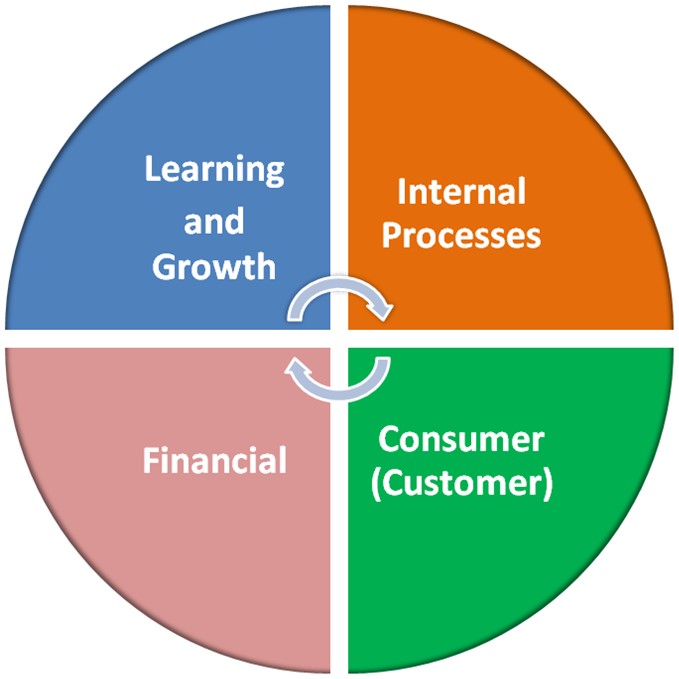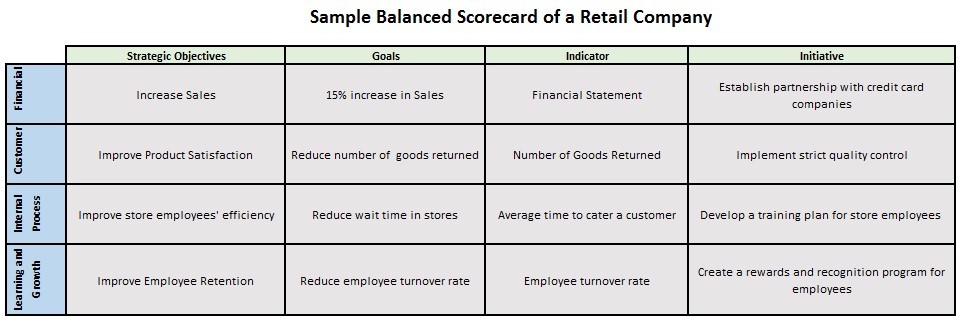Balanced Scorecard is a simple concept, but one I often see is not fully understood by people I associate with. It’s easy to see why, with many explanations of the system (particularly from the Balanced Scorecard Institute) getting bogged down in the details and history. So today I’m going to break down the basics of the system as quickly and simply as I can.
First and foremost, Balanced Scorecard is a top down system focused on the long-term growth and prosperity of a company. It acts as a manifesto and broad business plan in one, explaining the company’s main purpose, detailing areas the company needs to improve at executing that purpose, and concrete ways those areas can be improved.
This is first accomplished by looking at four perspectives to view the business from, usually represented as these four categories:

- Learning and Growth
- Internal Processes
- Consumer (or Customer)
- Financial
These can be easily broken down and understood by asking yourself a set of questions:
- How flexible, forward-thinking, and technologically savvy is my company (and its employees)?
- How efficiently does our organization operate?
- What is our relationship with our customers and how do they view us?
- Are we making a profit (and how much)?
Once you have the answers to these questions, you should start brainstorming ways your company can improve in each of these categories (if you can’t think of any, try harder. No company is perfect.). The results of this brainstorming session will be your Strategic Objectives, i.e. specific, concrete goals you can accomplish and keep accomplishing over a prolonged period that likewise have specific, measurable results. Stuff like “Increase Sales”, “Optimize Retention”, “Reduce Wait Times”. These objectives will vary based on the size, nature, and customer base of your business, but all will follow the same guidelines of things you can measure effectively and can reasonably affect by your own actions.
Don’t forget to pull it all together. Think of the four perspectives listed above as less one category and more four sub-categories. All of those perspectives can and should be used to improve upon the others. For example, optimizing employee retention (Internal Processes) can reduce wait times in your stores (ditto), which will improve customer satisfaction (Consumer), which will increase your sales (Financial). No part of a business exists in a vacuum.
Once you have your objectives and have figured out how they all fit together, just come up with some simple measures to keep track of how well you’re executing those goals. If your goal is to optimize retention, simply look at how many employees you have gained over a set timeframe versus how many you’ve lost. If that number has changed for the better since you have started implementing practices to improve (like more extensive training, better benefits, higher wages) then good, you have taken a step toward achieving your goal. If not, go back and see what you may have done wrong and implement new strategies to affect the problem.

So, this is all well and good for those steering a company, but you may ask “Why do I need to know this as an employee?” The simple answer is: Because it gives you context for what you do (and why you do it). While you may have no control over these objectives being put in place they will affect nearly every aspect of your workday if implemented properly. Knowing the why behind a task will make you better able to perform it. And, at least for me, knowing why I’m doing something (and why I’m being asked to do it a certain way) will often reduce my frustration. If you simply tell someone “There is a mandatory training session on Monday” they will likely bristle, thinking they’ve done something wrong. Additionally, informing them that it’s because of a company-wide shift to better prepare its employees for the future will likely negate that response. The same goes for informing yourself.
I hope this article helped demystify the subject. If you want a more in-depth explanation of the history and use of this method, there are other resources online. The Balanced Scorecard Institute is a particularly good one.
